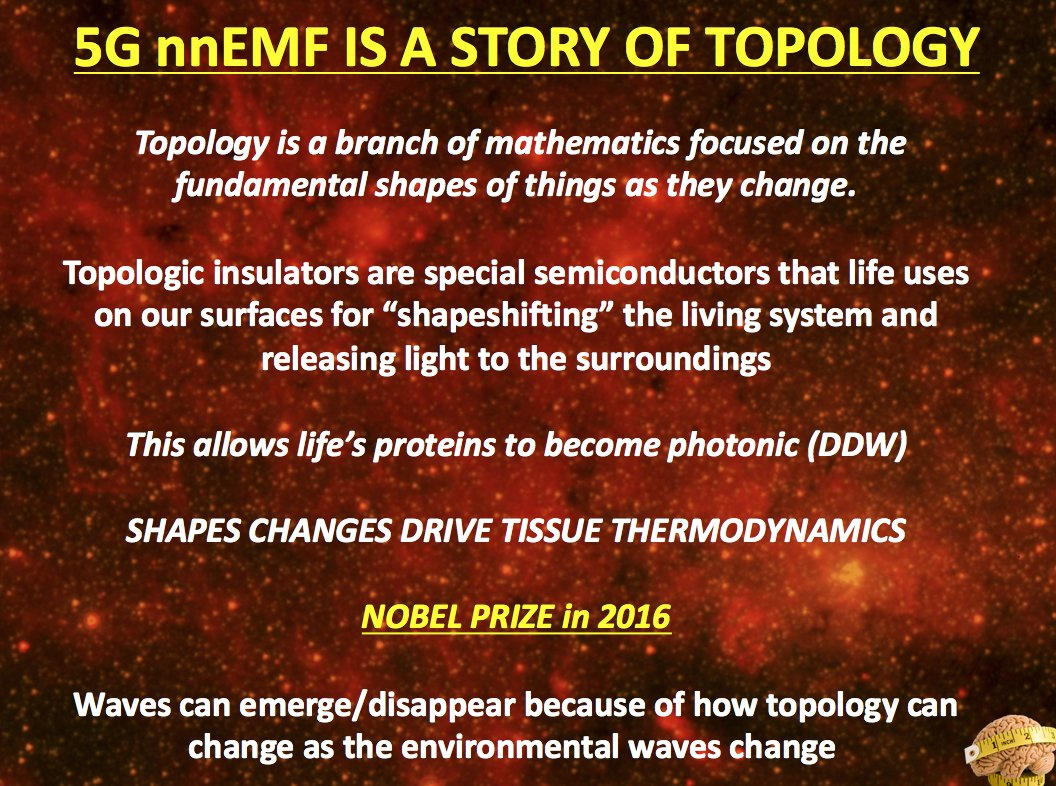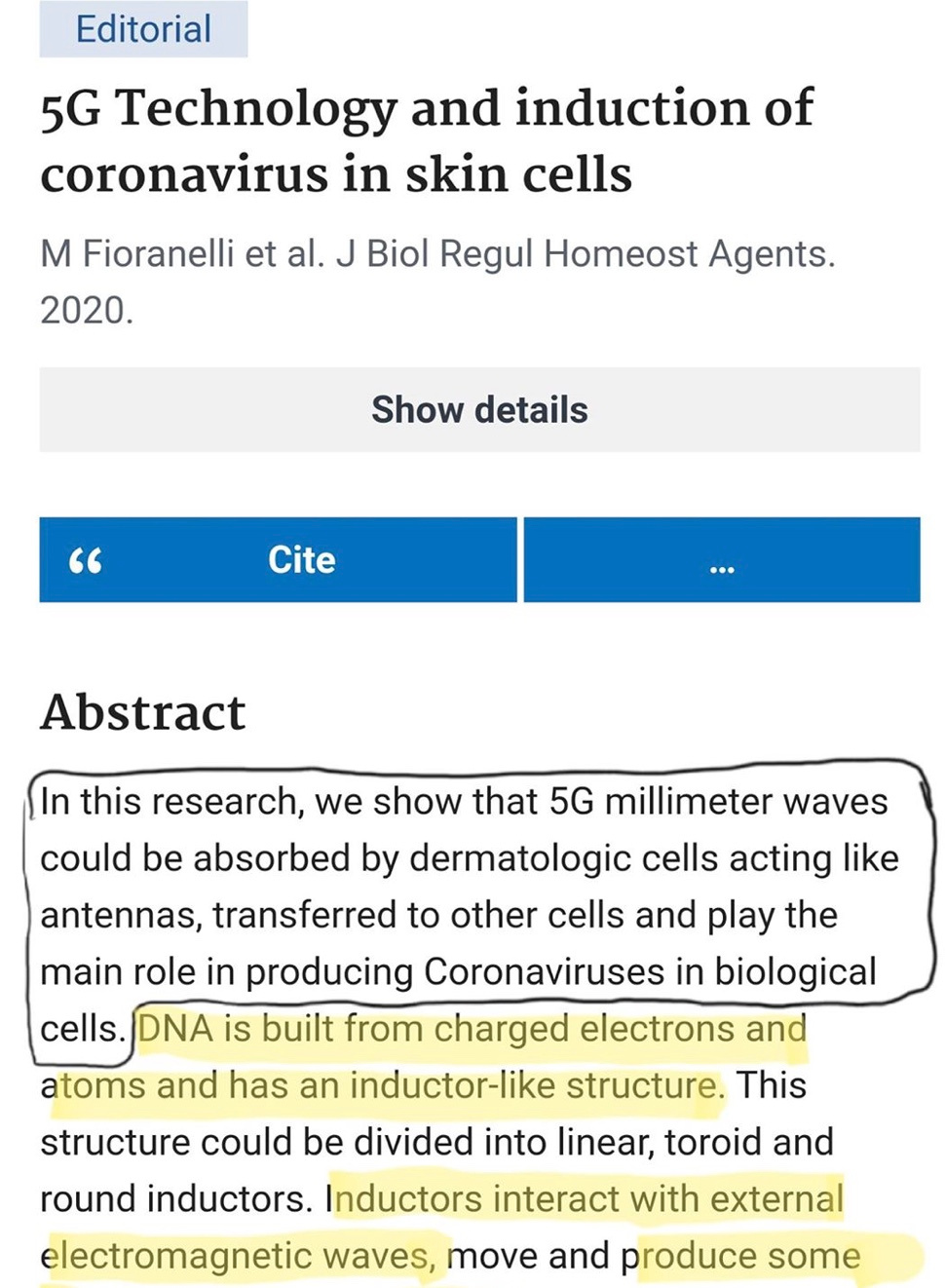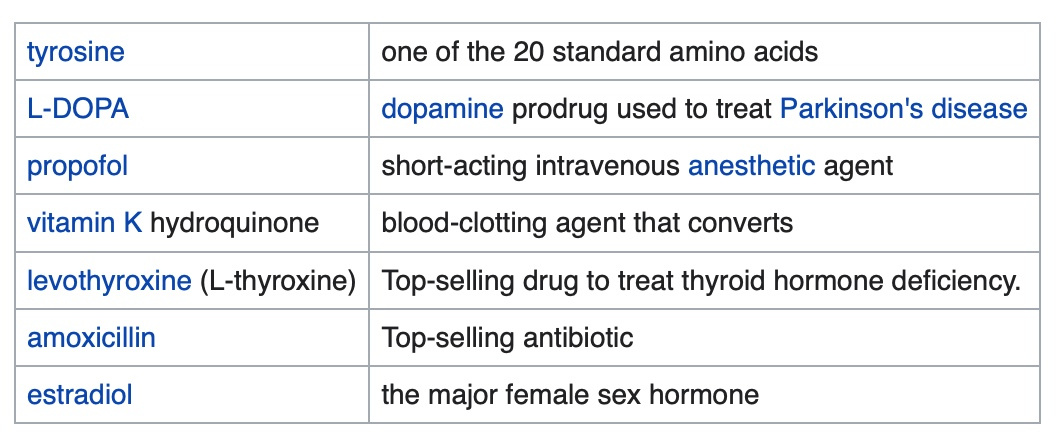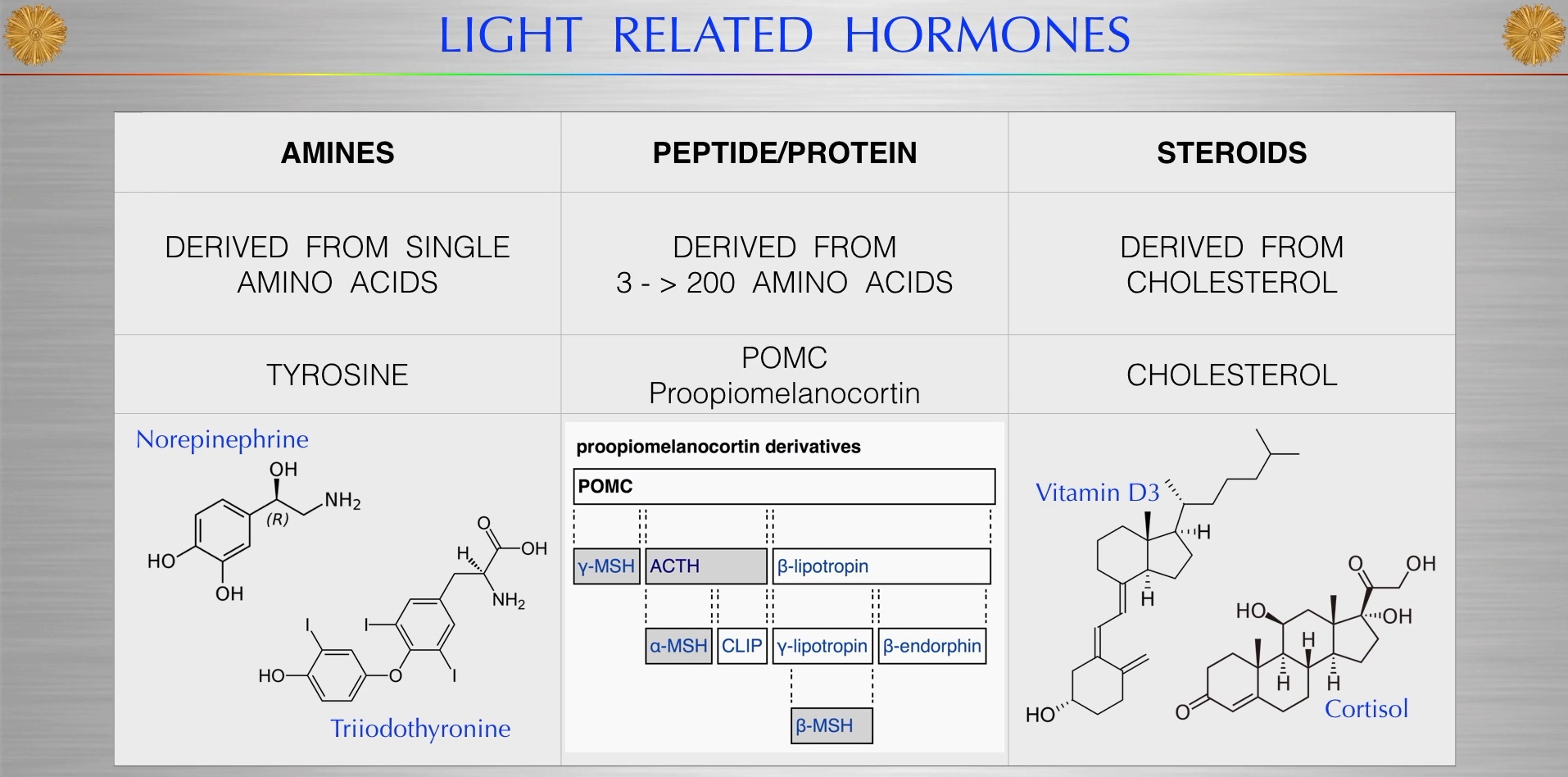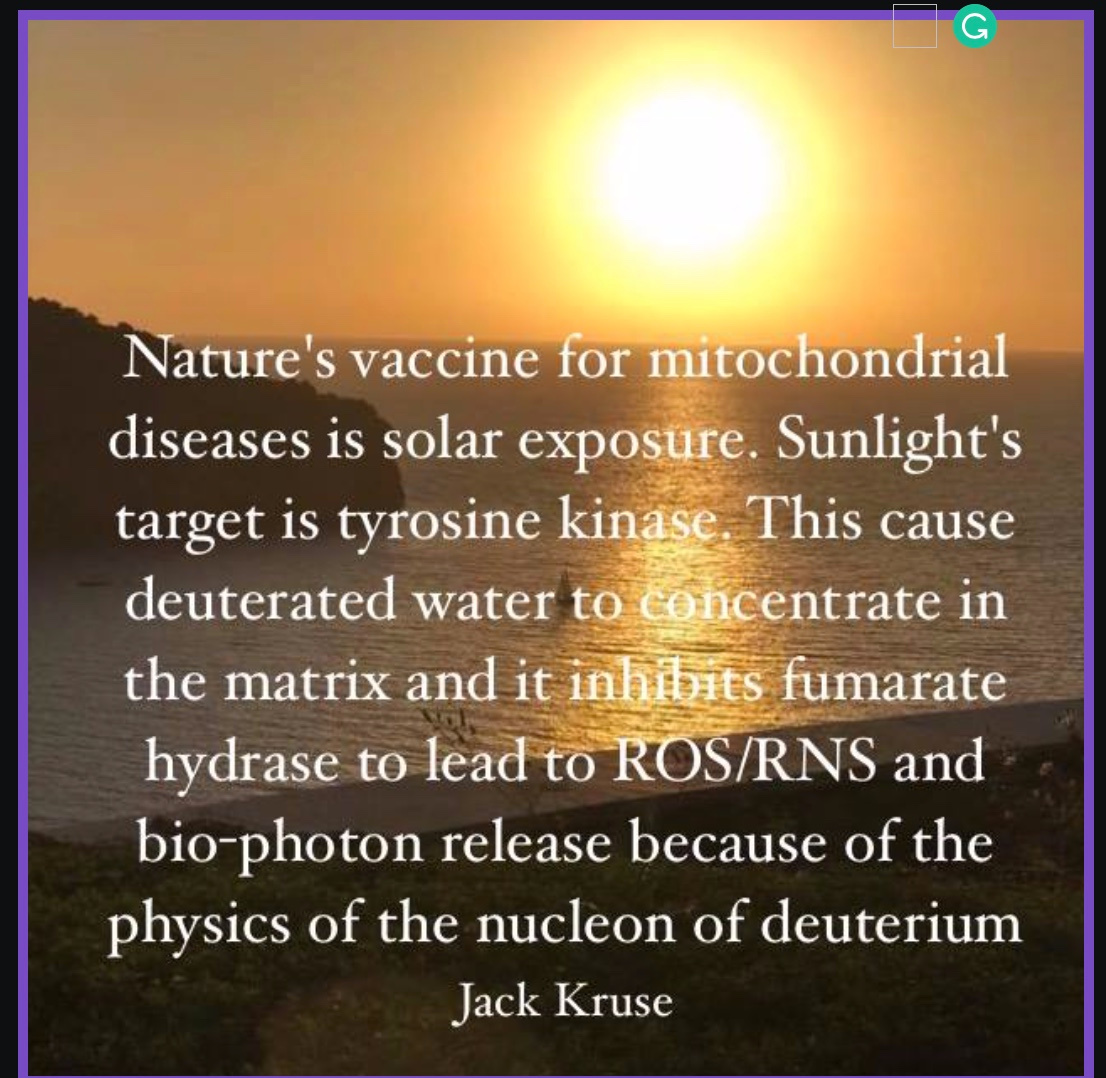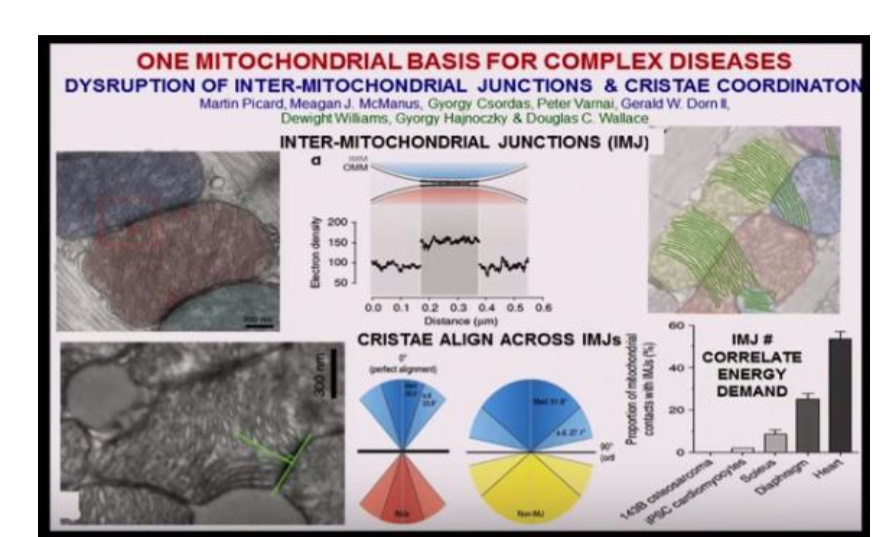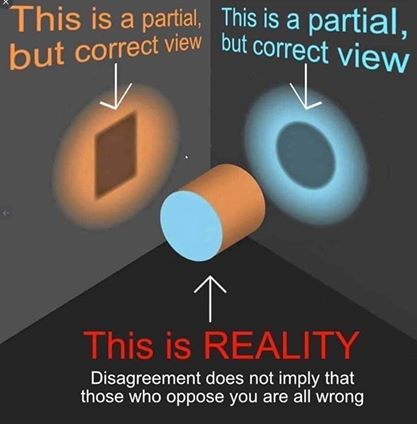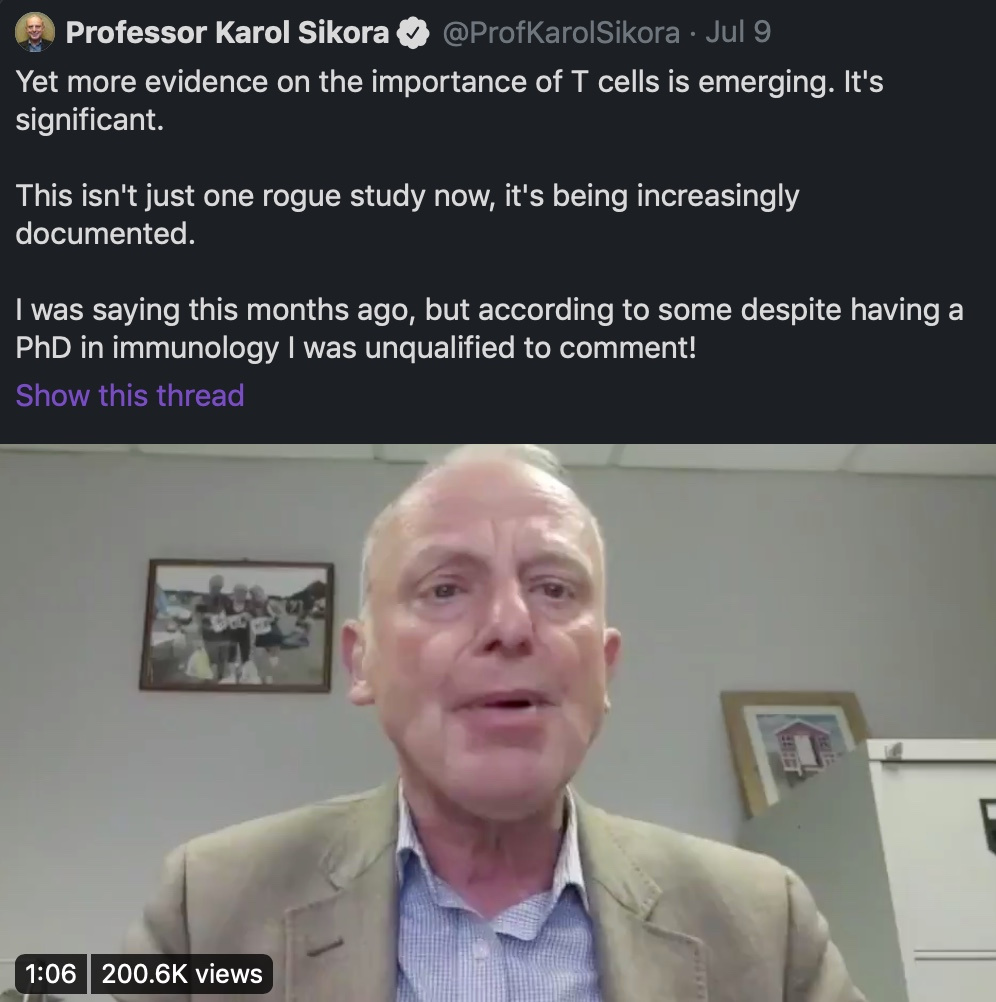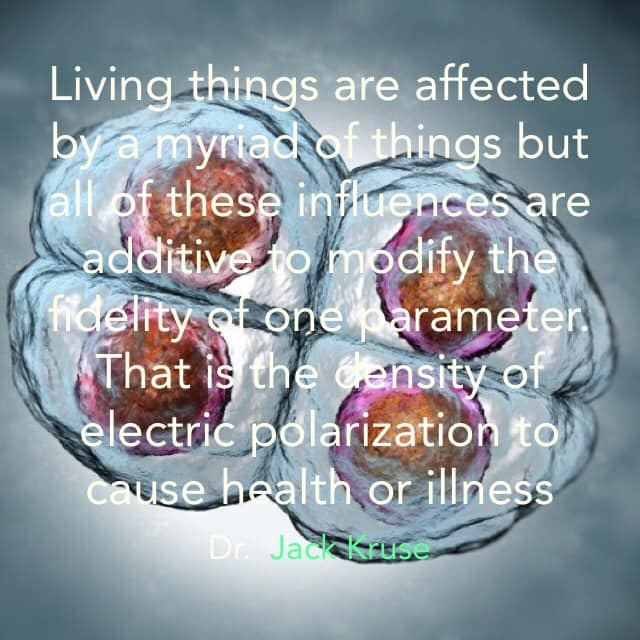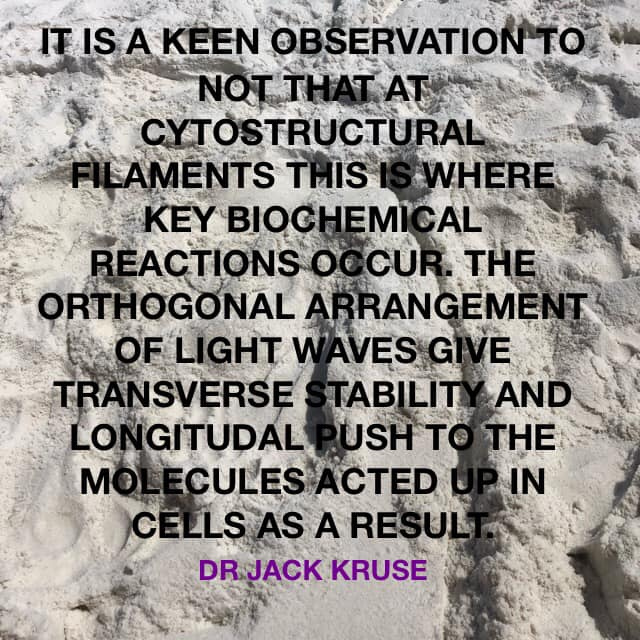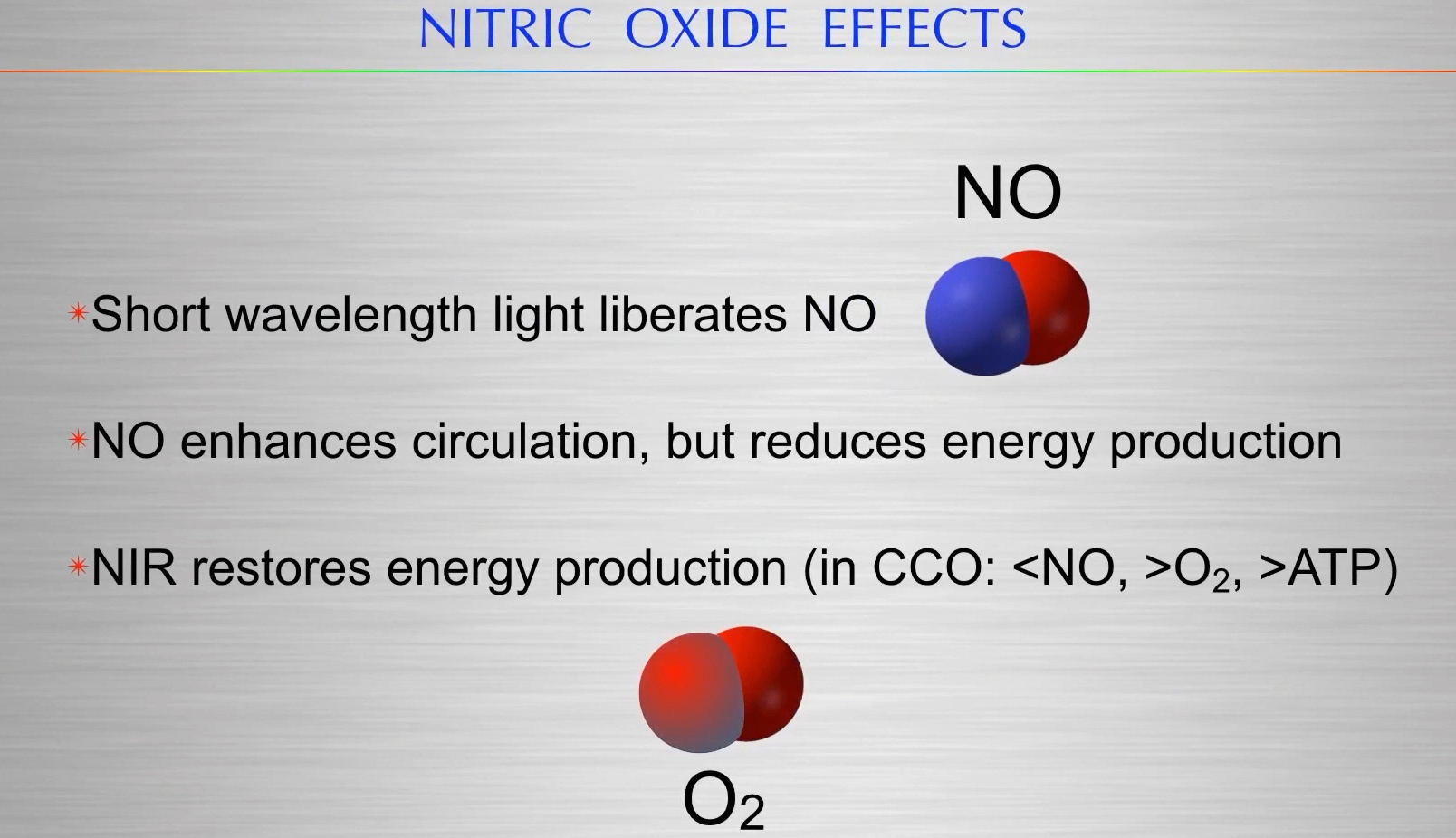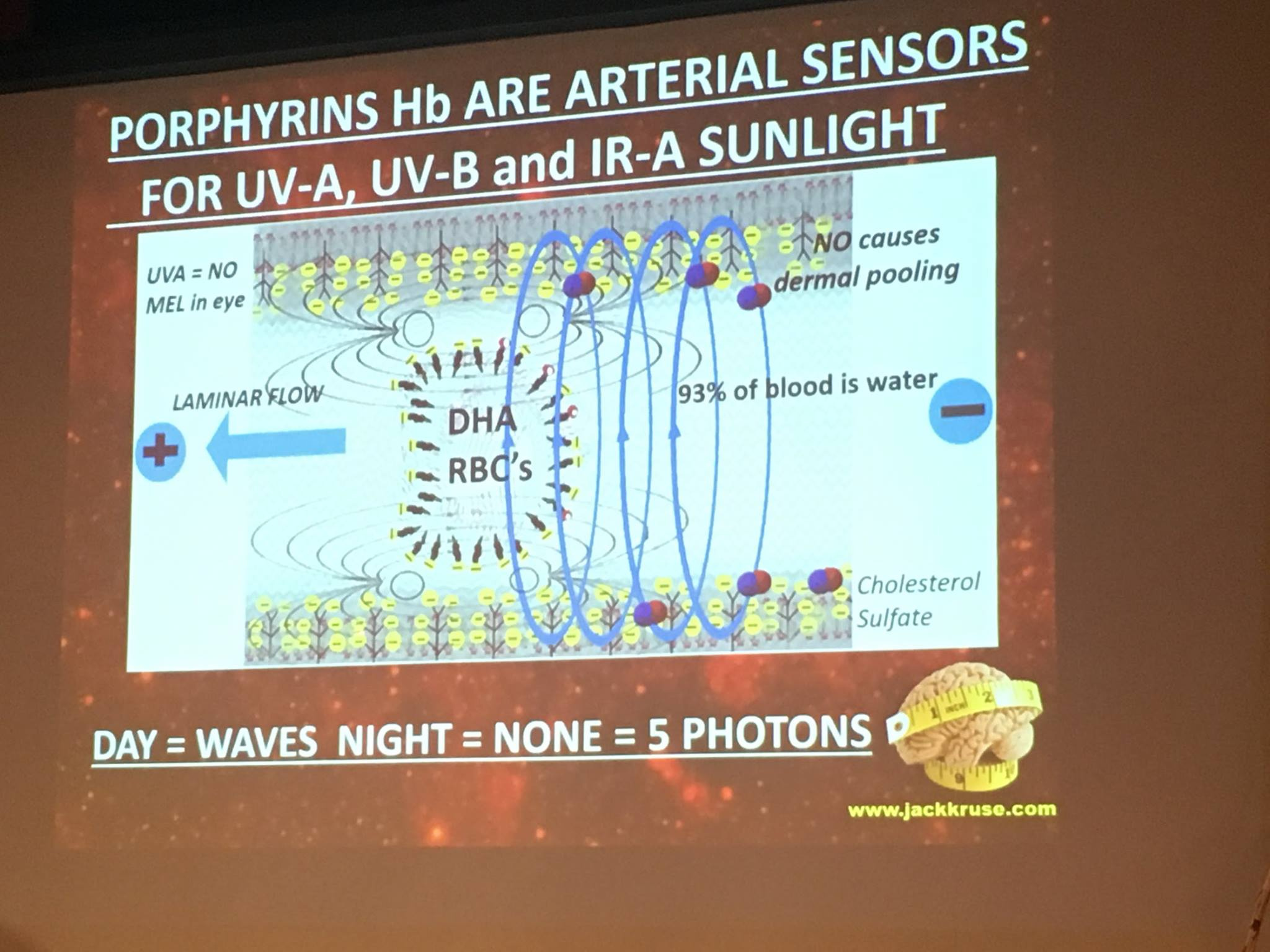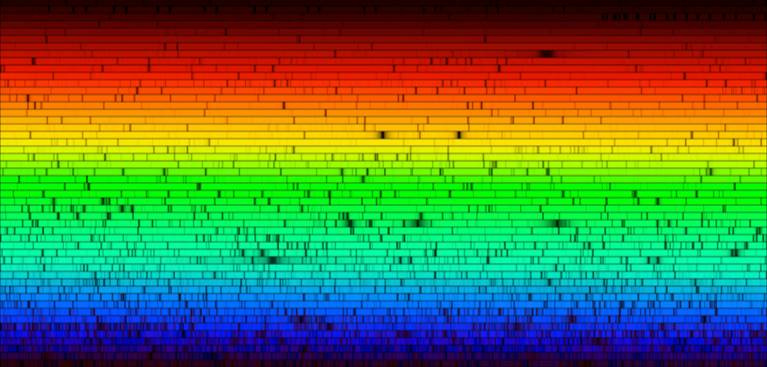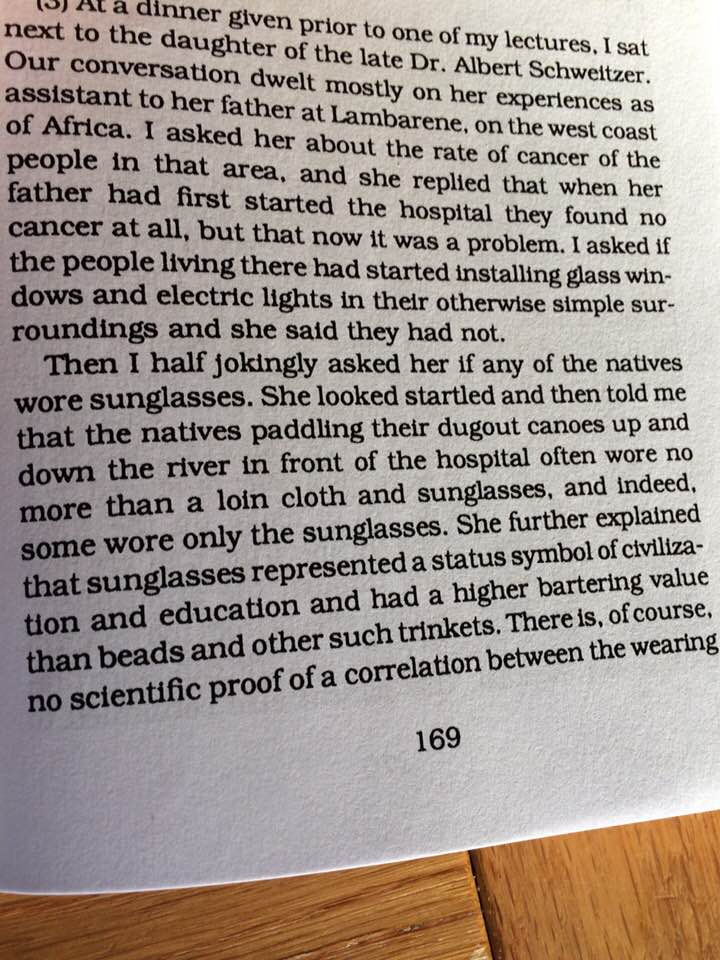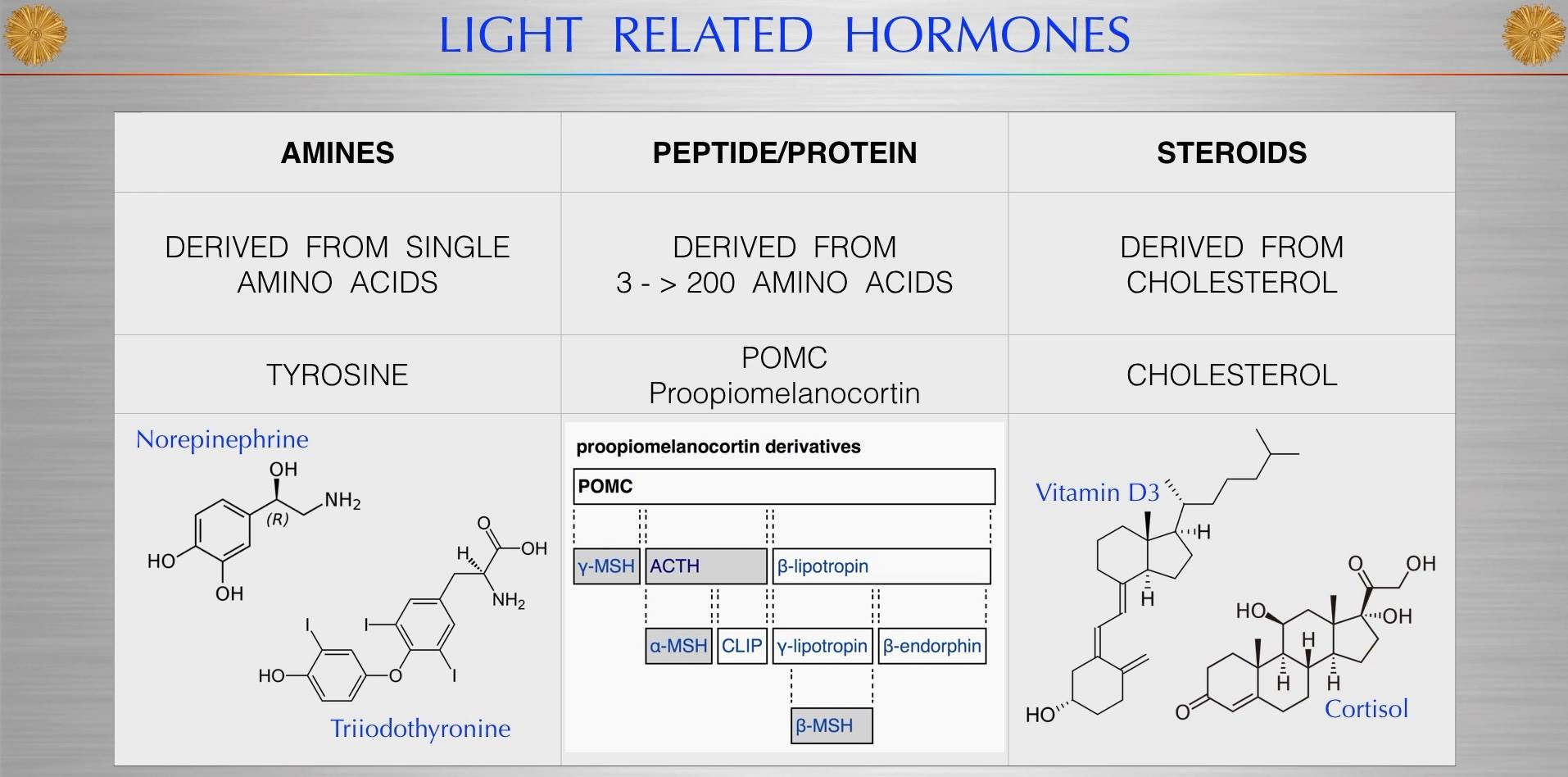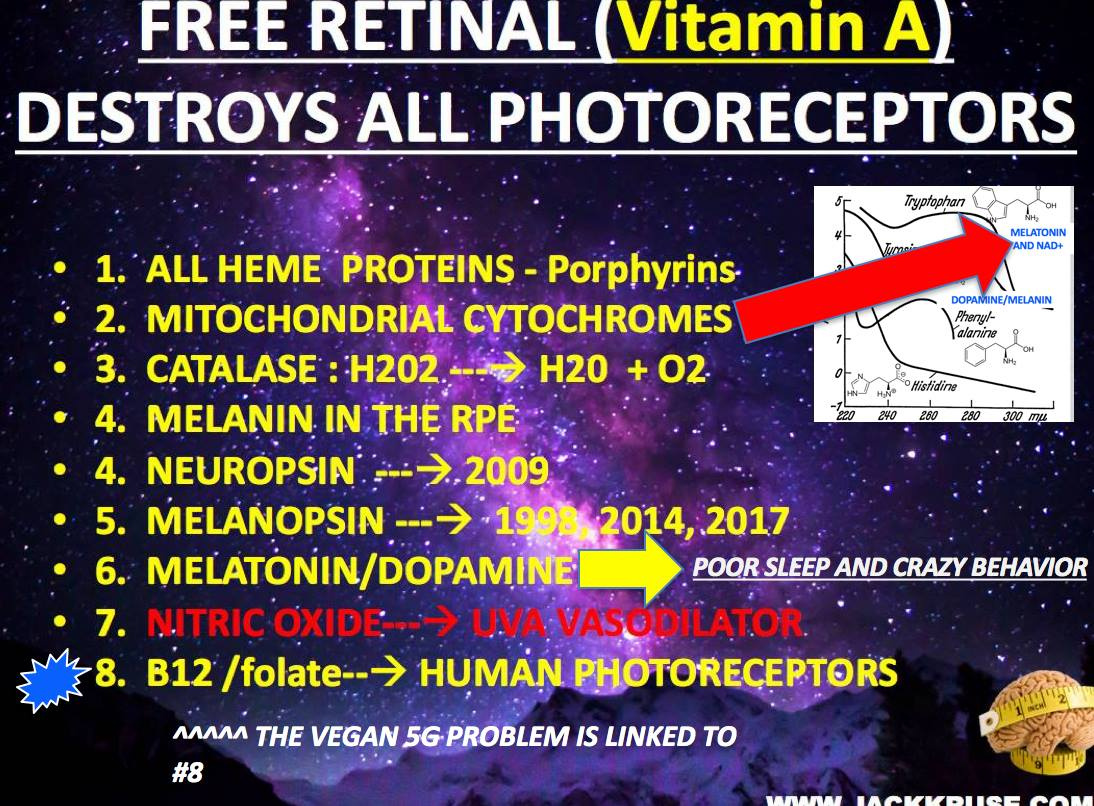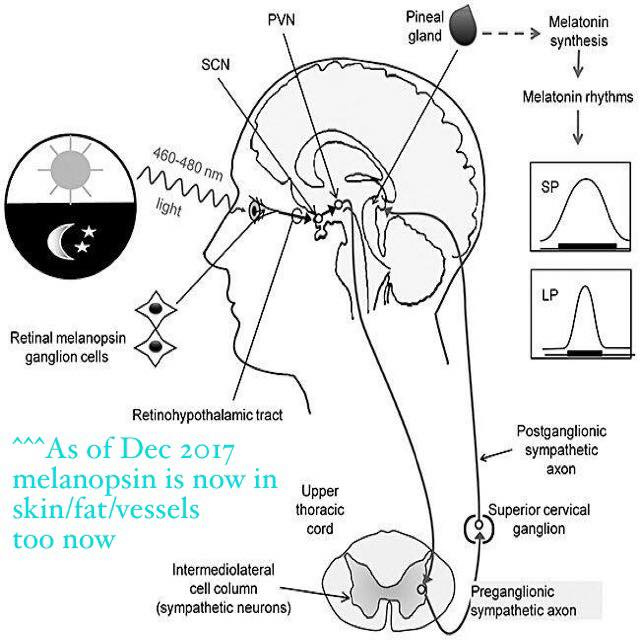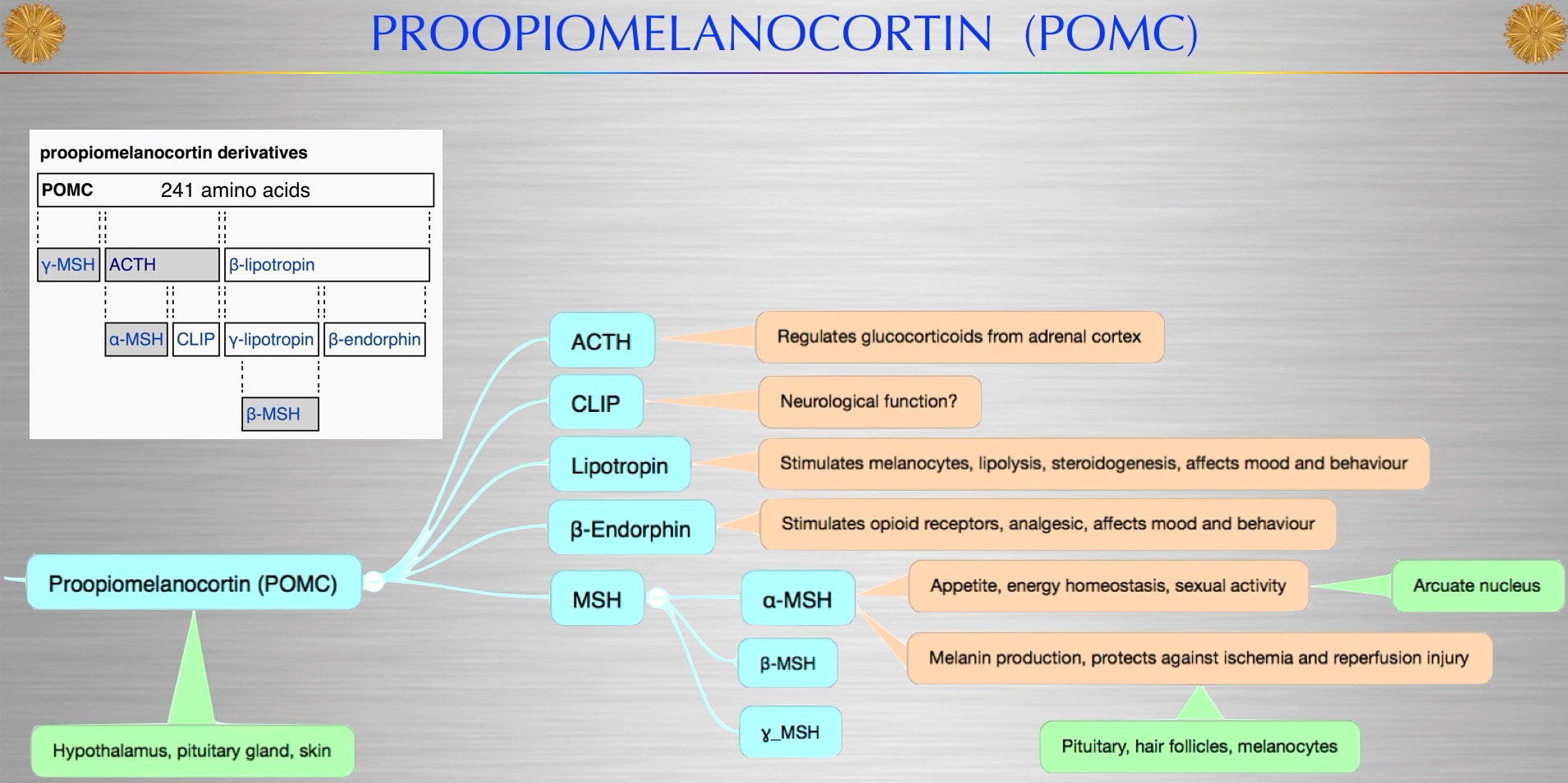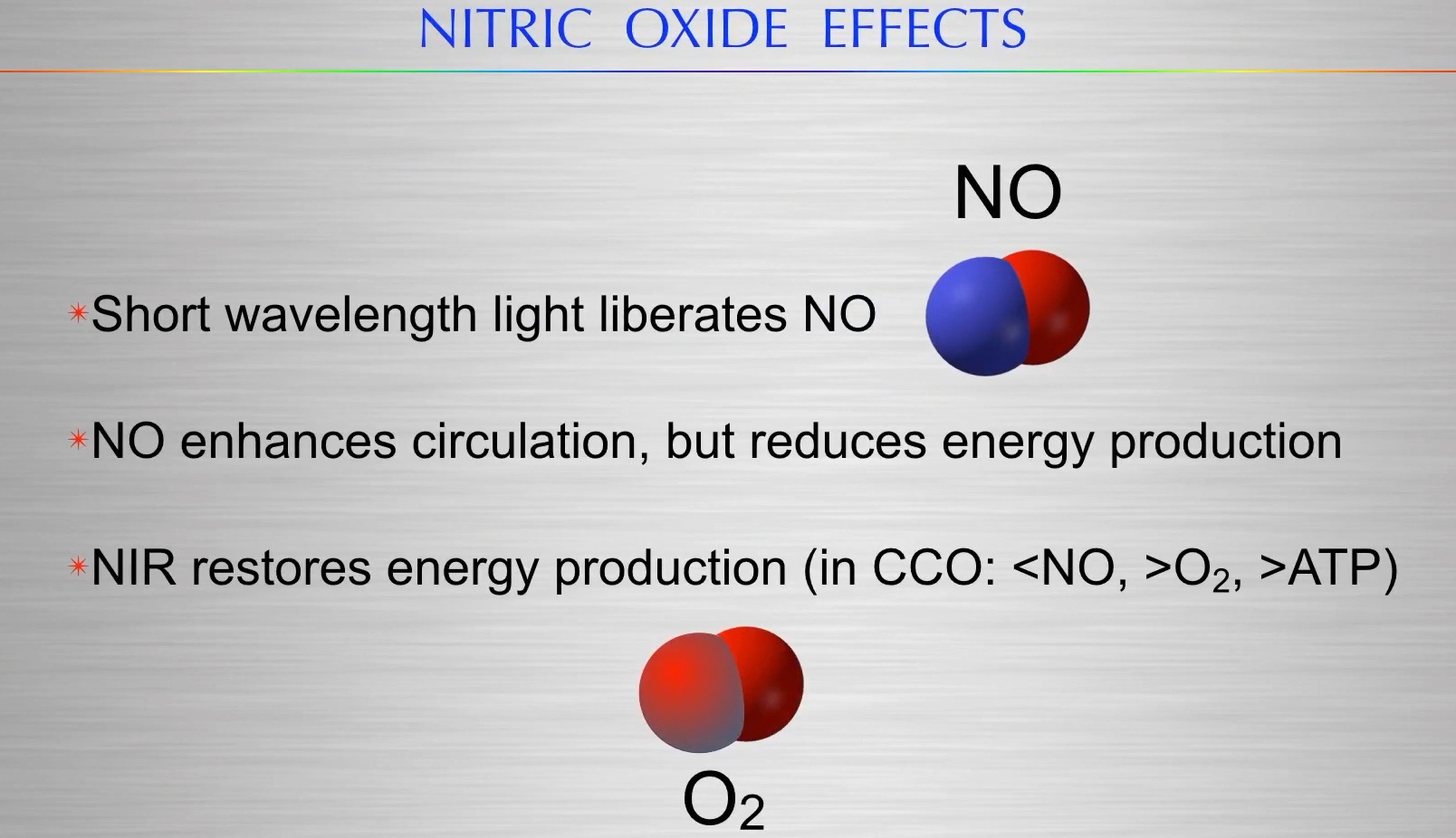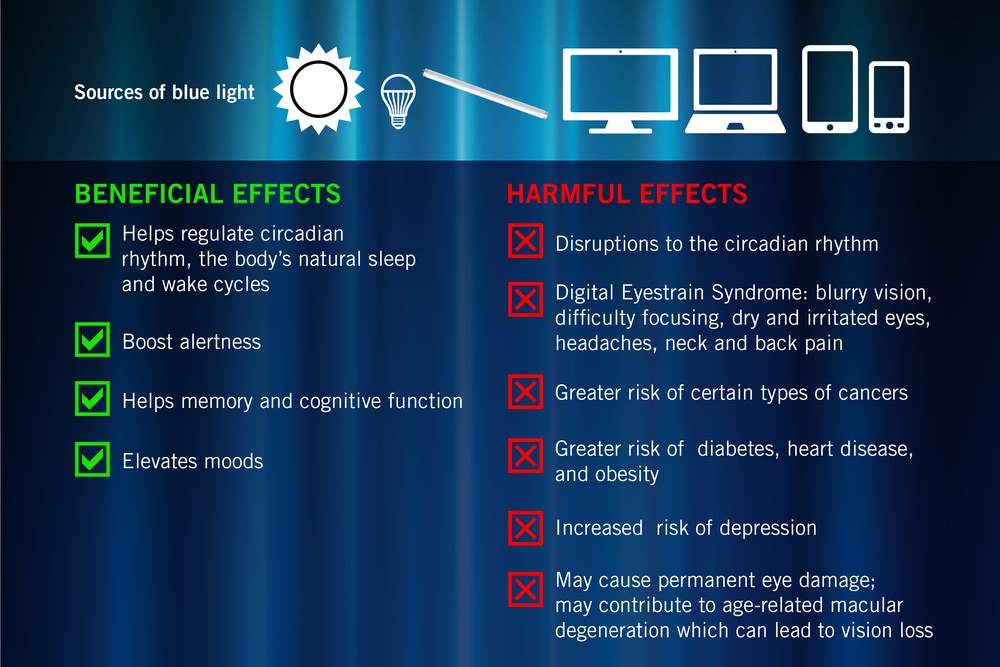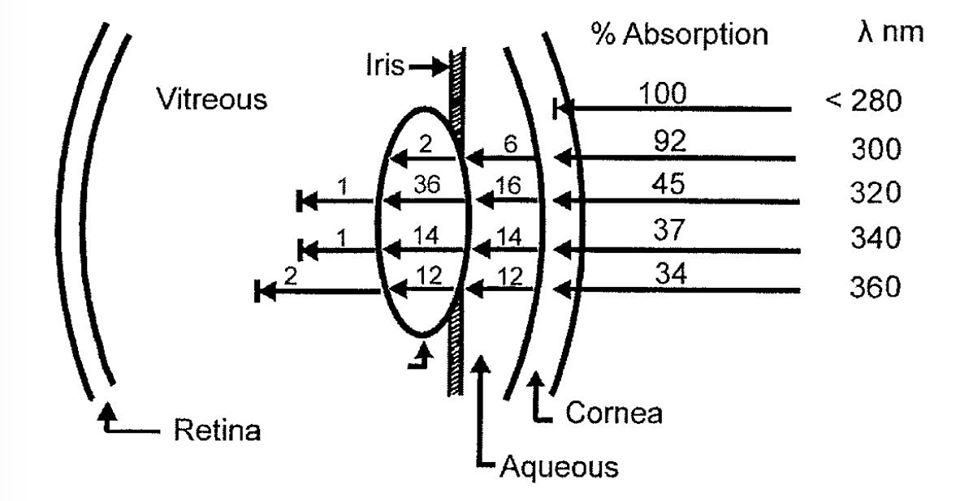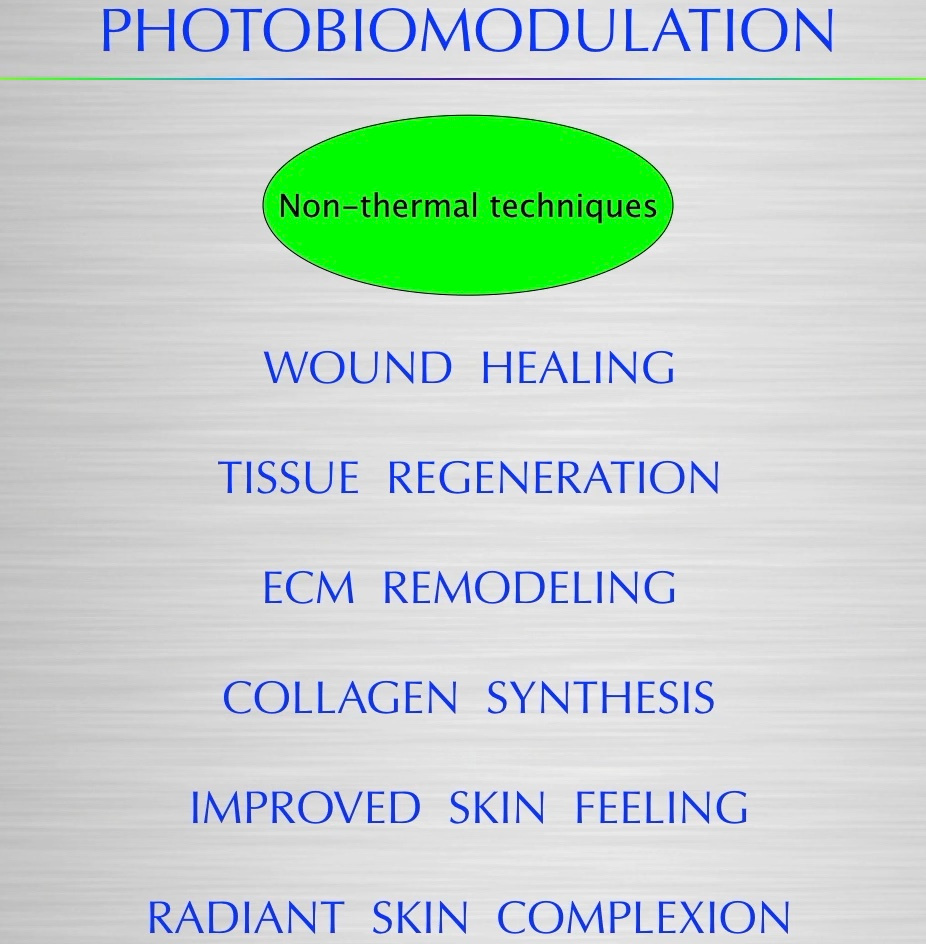I decided to take a lecture by Dr. Doug Wallace and break it down piece by piece to have attendees understand fully what the science of mitochondrial medicine is implying. I have been employing this technique in my personal training and mentorship of my clients at KruseatDestin.com and I decided to do this live for a group of 75 in July 2020.
Have a listen and tell me if you thought this was a good way to communicate science in the future.
Thanks for watching and this is synopsis of the implications of this lecture below.
The human body contains of many different organs and tissues but every one of these is made of cells and all of these cells have a similar basic structure and function.
Here I have drawn a human with the most important organs for my explanation. This is not to scale. This is the brain, the eyes, the skin, and the inside is a cell.
Every cell has a cell membrane that is semi-permeable meaning that it lets certain things in and out of the cell-like water, nutrients, and waste products.
Every cell has a cell nucleus that contains the DNA in the chromosomes. DNA codes for proteins that are made in the cell.
Every cell, except red blood cells, contains mitochondria. Mitochondria are the energy-producing part of the cell. They take the food you eat to make energy for the organs and the body to function. The number of mitochondria in a cell depends on the metabolic function of the cell. High energy consuming organs like the heart and brain have many thousands of mitochondria per cell. Whereas a fat cell has far fewer mitochondria. Here I have just drawn one.
The health of your body depends on the energy your mitochondria can make. Tissues that get diseased have poorly functioning mitochondria. So if you have a skin disease or diabetes or heart disease or brain disease it means the mitochondria in those organs are not working.
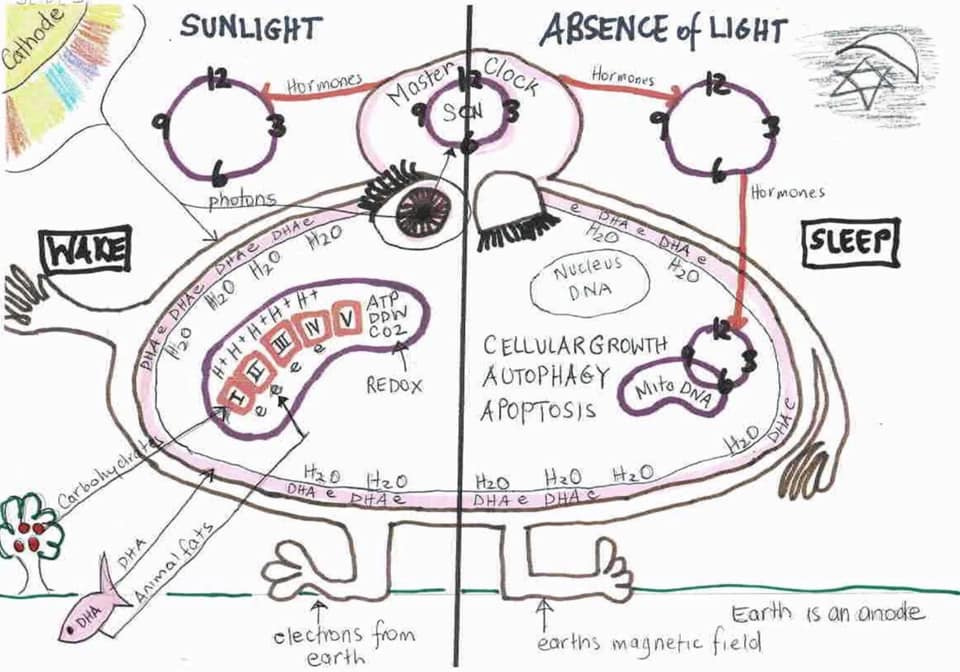
Therefore understanding how a mitochondria functions are fundamental to reversing or preventing diseases of just about any kind even genetic diseases.
Inside the mitochondria, there is an electron transport chain that consists of 5 cytochromes.
All food is broken down into subatomic particles called electrons and protons. Electrons have a negative charge and protons have a positive charge. The mitochondrial electron transport chain separates the positive and negative charged particles across the inner mitochondrial membrane and the electrons are used to make ATP, CO2, and a special kind of water called deuterium depleted water (DDW).
The ATP and DDW are used in the cell for metabolic functions. CO2 is a waste product that is breathed out.
The ability of your mitochondria to collect and separate electrons and protons and make ATP, CO2 and DDW is called the REDOX which is short for the chemical reactions of reduction and oxidation that the mitochondria perform. When mitochondria are functioning well they make lots of ATP and DDW that your cells and organs use to keep all the metabolic processes in the body functioning appropriately to avoid disease.
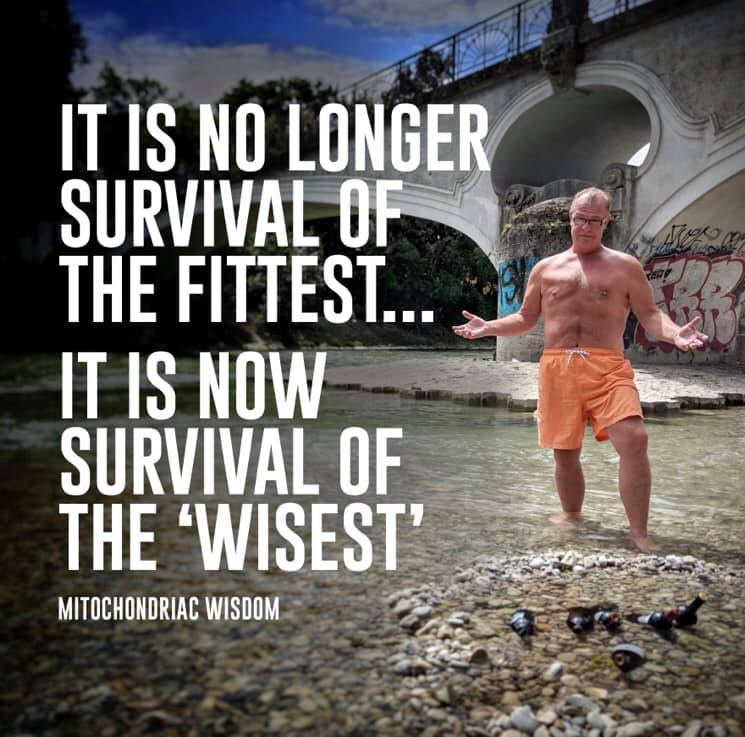
The most important organs for mitochondrial function are the skin, the eyes, the brain. Inside the brain, there is a small region called the suprachiasmatic nucleus (SCN) that is the master clock controller of all circadian rhythms in the body. Circadian rhythms are biological processes in the body that have a 24-hour cycle. In humans, this is the daily wake, sleep cycle.
There are approximately 37.2 trillion cells in the human body and the proper function of each one depends on the master clock controller to make sure they act at the appropriate time of the day or night. When cells get disconnected from the master clock controller mitochondria can no longer work as well and this lowers their REDOX meaning they make less ATP & DDW. In order for the master clock to control the daily sleep/wake circadian rhythms of 37.2 trillion cells, it must get signals from the environment to tell what time of the day or night it is. The environment is the sun, the earth, the food, and water.
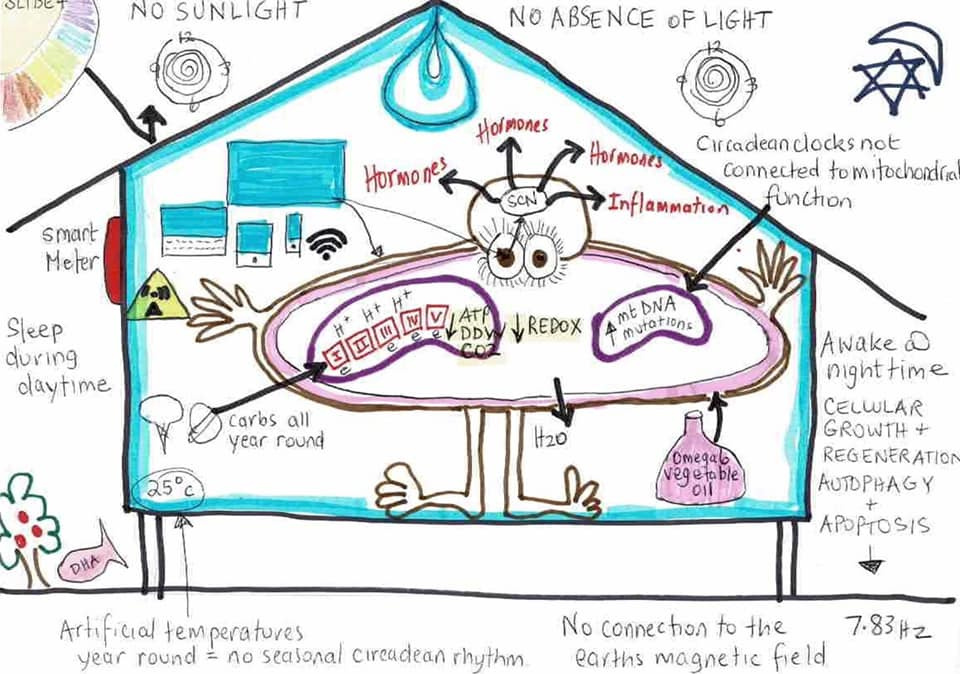
Sunlight is absorbed through the eyes and skin and tells the master clock what time of the day it is. From the very first light of the day, before sunrise, photoreceptors in the skin begin to detect the rising sun. This releases hormones that start to wake you up.
As the sun rises there are different frequencies of sunlight and these varying frequencies are specific signals to the SCN for hormone release to wake the body from unconscious sleep to conscious wakefulness and movement.
Early morning UVA and IRA sunlight in the eyes and skin makes melatonin. Melatonin is the sleep hormone and the hormone that protects mitochondrial function and circadian rhythms. Melatonin is released at night time after 4 hours of darkness. Melatonin is turned down or even off by any light exposure after sunset.
Early morning sunlight makes dopamine that is needed for proper mental health, learning, and memory. UVB sunlight on the skin makes vitamin D from cholesterol that is needed for immune function.
Sunlight makes vitamin B12. UV sunlight stimulates red blood cell synthesis. UV sunlight on the skin increases venous oxygen. Sunlight on the skin lowers blood pressure.
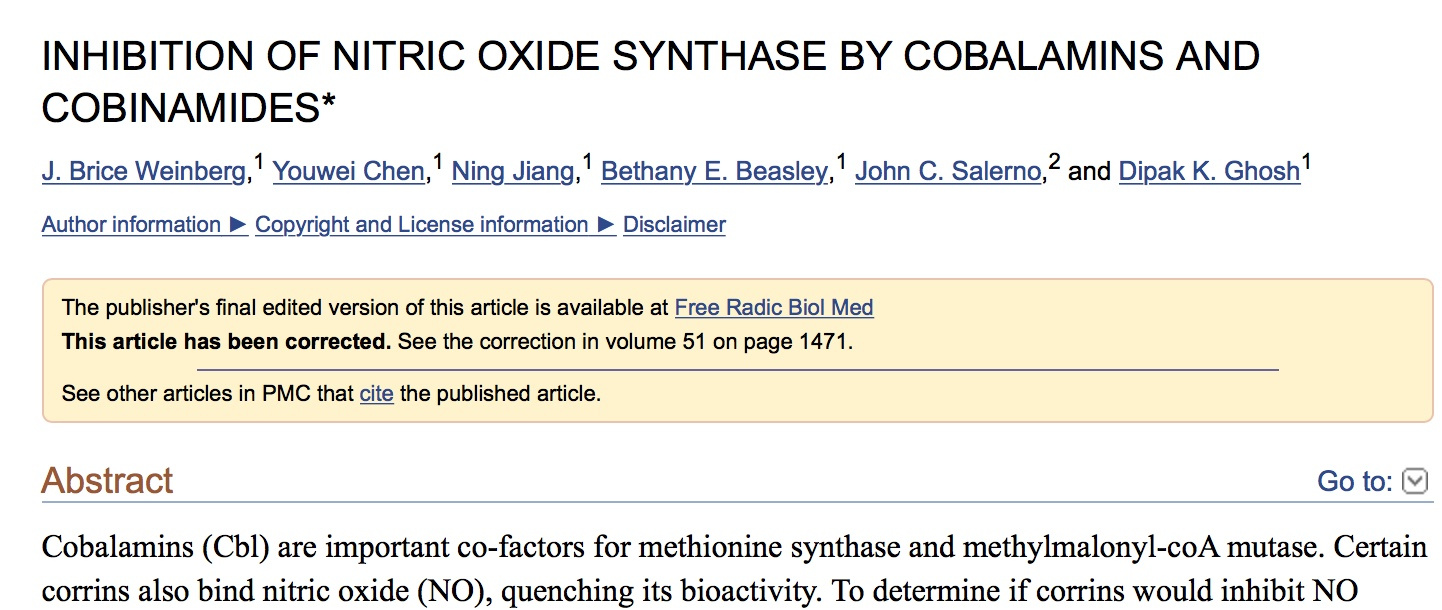
Early morning sunlight increases melanin in the eyes, skin, and hair. The more melanin you have the more sunlight energy you can collect.
During the daylight, humans eat food that is broken down into electrons and protons in the mitochondrial electron transport chain to make ATP, DDW, and CO2. The mitochondria supply the energy for the daily movement and functions of the body.

Sunlight has specific frequencies of visible light – red, orange, yellow, green, blue, violet and humans detect and use these frequencies for specific cellular signaling, hormone and neurotransmitter production.
These frequencies vary in intensity throughout the day and this is the signal that the master clock uses to control every cell in the body via hormones that are released at different times of the day.

Every gene in the human genome has a clock gene in front of it and these are controlled by the light and absence of light detected by the SCN.
At sunset, there are photoreceptors in the eyes and skin that detect the waning sunlight and then the absence of light on the eyes and skin is also a signal to the master clock to prepare for sleep by releasing hormones.
During sleep cells undergo cellular growth and metabolism that grows new cells, recycles the components of some cells, and replaces other cells.
Growing new cells such as building up muscle cells to respond to exercise. Some cells in the body are replaced regularly like skin and gut cells. Others, like brain and heart cells, have their components recycled.
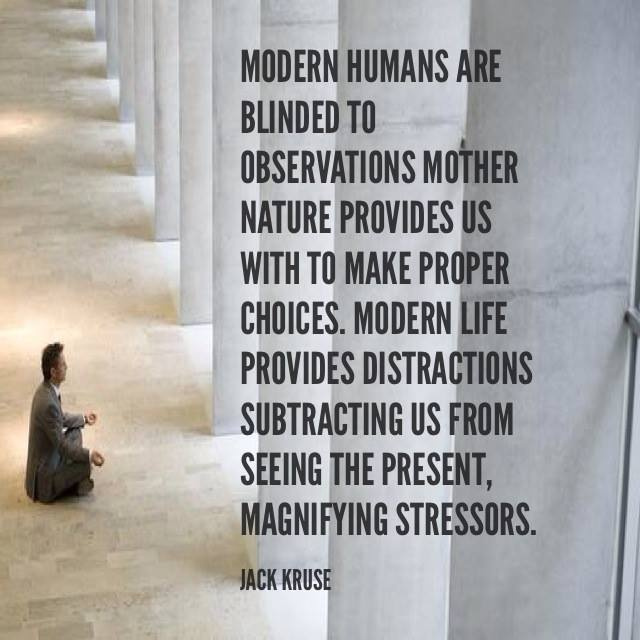
Cellular recycling is called autophagy and cellular removal is called apoptosis. Mitochondria also undergo recycling and replacement called mitophagy.
These are all controlled by mitochondria based on the circadian rhythms dictated by the master clock controller. That is the sunlight and darkness signals detected by the eyes and skin.
Sleep at night time during darkness is the most important daily health activity. The only way that photons from sunlight can interact with humans is via electrons. Electrons collect and carry photons and release them at particular times and places in the cell.
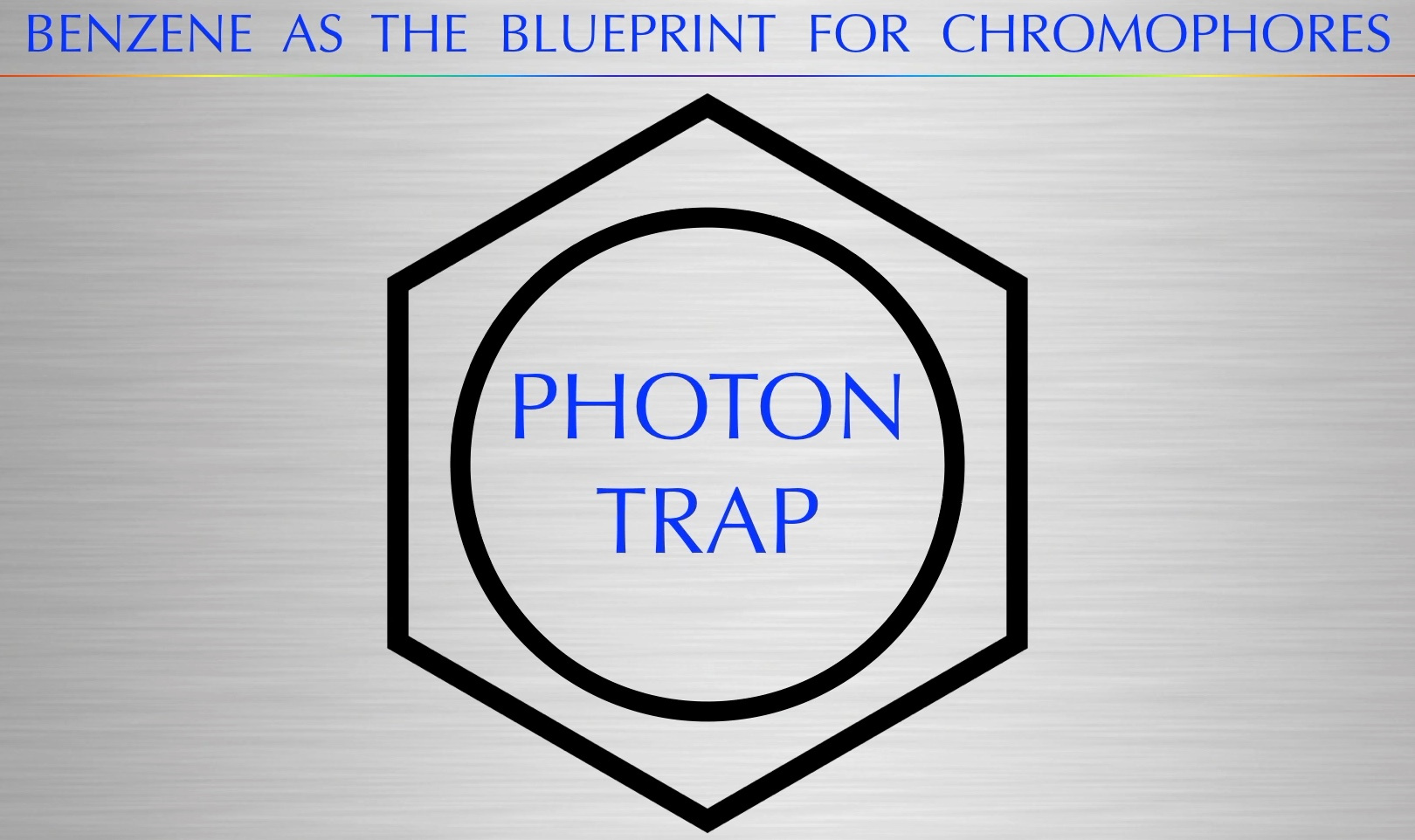
Photons carry information about the time of the day and the season to mitochondria and mitochondria vary their functions in daily and seasonal patterns.
For a human cell to collect electrons it needs docosohexanoic acid (DHA) in the cell membranes. DHA is an electron-rich omega 3 fatty acid that is obtained from marine foods and not burned as energy but is rather used in cell membranes.
DHA is particularly abundant in the eye and brain cells because these cells collect and transform a lot of light. Seafood also contains the iodine and selenium cells need to assimilate DHA into cell membranes. Seafood must be eaten regularly.
DHA in cell membranes turns sunlight into a DC electric current that cells use for growth and metabolism.
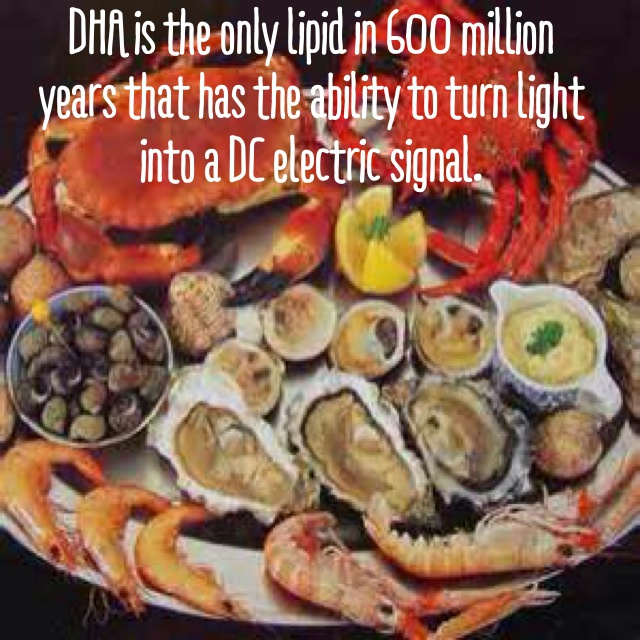
Human cells also contain water and this water is not just sloshing around. Inside the cell and the blood plasma and cerebral spinal fluid (CSF) it has specific crystalline molecular structure and function that allows it to behave like a battery to collect and separate electrons and protons to form an exclusion zone (EZ) that acts like a battery. EZ water absorbs sunlight and the electrons in water collect photons to deliver them to the mitochondria.

All food is broken down into electrons and protons and is fed through the mitochondrial electron transport chain. Carbohydrates typically grow in summer or tropical climates and this food carries photons on its electrons that tell the mitochondria what season it is.
Electrons from carbohydrates are fed through cytochrome I of the ETC and the photons these electrons carry tell the mitochondria that it is summertime. In the summertime, mitochondria replace and recycle themselves = mitophagy. This is important to keep mitochondrial REDOX working well.
In winter carbohydrates do not typically grow and the human diet is naturally animal fats. Electrons from animal fats go to cytochrome II and carry lower frequency photons from the winter sunlight. Mitochondrial release different signaling molecules (reactive oxygen species = ROS) in summer and winter.
The circadian clocks of the SCN, cells, mitochondria and all the genes need these light signals on the eyes and skin to match the food signals to keep the body functioning in a globally controlled system.

The important message is that humans, just like wild animals, should eat what grows naturally in the environment they live in so the signals from the electrons and photons in the food they eat matches the sunlight and temperature detected by the eyes and skin. This enables the SCN to coordinate circadian rhythms for every cell in the body.
Humans are also meant to be barefoot on the earth daily where the 7.83 Hz magnetic field tunes all the electromagnetic atoms in the body. The magnetic field is created by sunlight hitting the earth and it varies daily and seasonally.
The magnetic field is stronger at night time when sunlight is absent. The earth is also a source of free electrons that can be collected when animals like humans are barefoot on the earth. Grounding to the earth lowers blood pressure.
Humans evolved on the east African rift naked and barefoot eating marine food. This is the natural diet and lifestyle for humans. Humans later migrated to colder places around the globe where the sunlight is weaker. In these places, humans evolved adaptations to weaker sunlight and low vitamin D by changing mitochondrial function to make more heat and lighter eyes, skin, and hair.
Humans no longer live in the natural environment they evolved in. Humans these days live 90% of their lives indoors, disconnected from the earth and the sun, and the seasonal temperature variations.
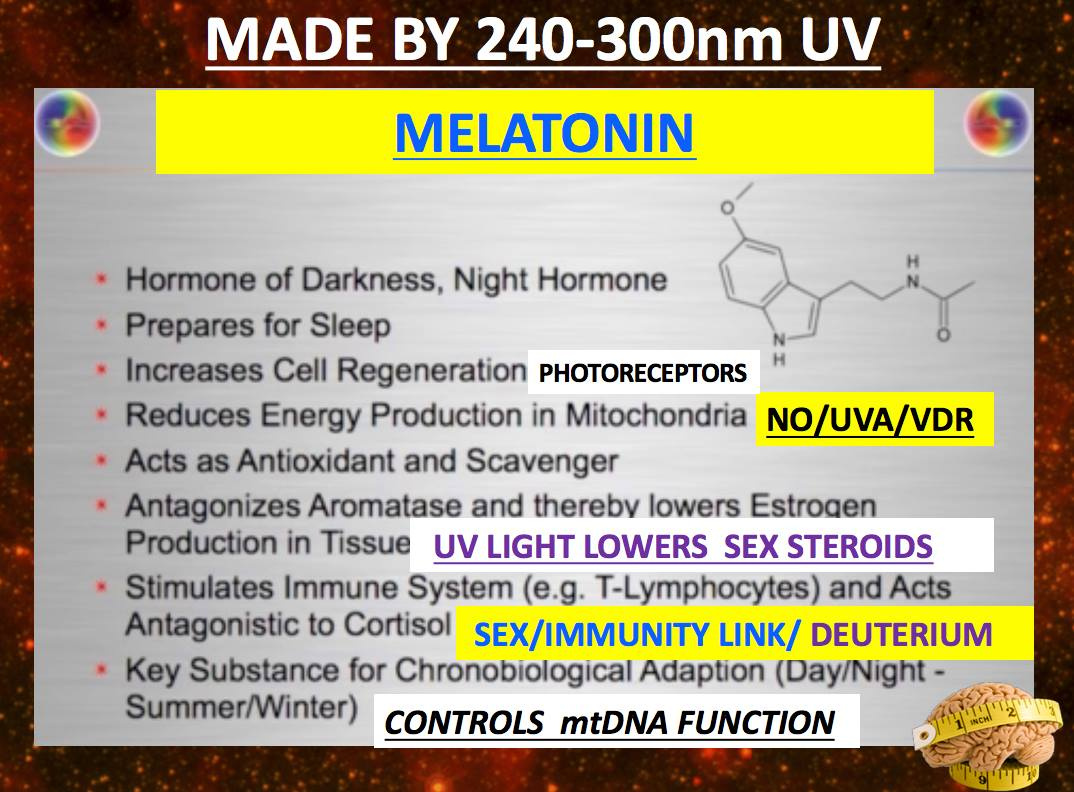
Humans these days are bathed in artificial light 24 hours a day and nonnative electromagnetic frequencies from communications and the power grid. The artificial electric and magnetic fields are detected by cells and this changes gene expression. Nonnative EMFs increase blood glucose levels to cause diabetes and chronic kidney disease. Nonnative EMFs interfere with heart and brain electrical rhythms. Non-native EMFs caused cancer and mental illness.
Artificial light does not resemble sunlight at all as it does not have the appropriate combination of frequencies of light and has very high levels of blue and green. Blue and green light in sunlight are only available at certain times of the day and come with the other frequencies. Blue and green promote wakefulness and their absence promotes sleep.
Humans no longer experience darkness after sunset and this has serious consequences for sleep, circadian rhythms, hormones, and control of cellular metabolism in every cell of the body.
Mitochondria lose control of autophagy and apoptosis and this leads to cellular dysfunction and diseases.
Without sunlight and darkness hormones can not be made and released at the appropriate times of the day and night. This causes insomnia and daytime sleepiness that reduces health and well being.

Humans no longer eat seasonal local naturally grown foods. They eat artificially grown foods that do not contain the appropriate energy and information from natural seasonal photosynthesis.
Carbohydrate electrons carrying blue light photons are eaten year-round and this uncouples circadian rhythms. There is a constant summertime environmental signal from lighting, air-conditioning, and clothing in the modern human lifestyle and this changes the epigenetic gene expression leading to diseases.
Humans don’t eat enough seafood and they eat a lot of processed carbohydrates, grain-fed animals, and vegetable oils. Grain-fed animals have high levels of omega 6 in their fats. Vegetable oils are very high in omega 6 fats that compete with DHA for a place in cell membranes. Combined with a lack of DHA from the diet this seriously compromises cellular function.

Humans no longer eat seasonal local naturally grown foods. They eat artificially grown foods that do not contain the appropriate energy and information from natural seasonal photosynthesis.
Carbohydrate electrons carrying blue light photons are eaten year-round and this uncouples circadian rhythms. There is a constant summertime environmental signal from lighting, air-conditioning, and clothing in the modern human lifestyle and this changes the epigenetic gene expression leading to diseases.
Humans don’t eat enough seafood and they eat a lot of processed carbohydrates, grain-fed animals, and vegetable oils. Grain-fed animals have high levels of omega 6 in their fats. Vegetable oils are very high in omega 6 fats that compete with DHA for a place in cell membranes. Combined with a lack of DHA from the diet this seriously compromises cellular function.

Cell membranes that lack DHA can’t efficiently collect electrons and photons and turn sunlight into a DC electric current. This reduces the REDOX of the mitochondria decreasing the ATP and DDW that cells need and leads to inflammatory signals and cellular dehydration.
Non-native EMFs also cause cellular dehydration that decreases the battery capacity of EZ water in the body further compromising the number of electrons and photons and protons that can be delivered to mitochondria.
Humans these days drink fluoridated water and consume brominated foods. These chemicals decrease the battery capacity of water in the body and increase cellular dehydration no matter how much water you drink.
Dehydrated skin cells can not produce vitamin D even if they are exposed to UVB sunlight. Combined with a lack of sunlight exposure humans these days live with chronically low vitamin D that causes cancer, autoimmunity, mental illness, and neurodegeneration.
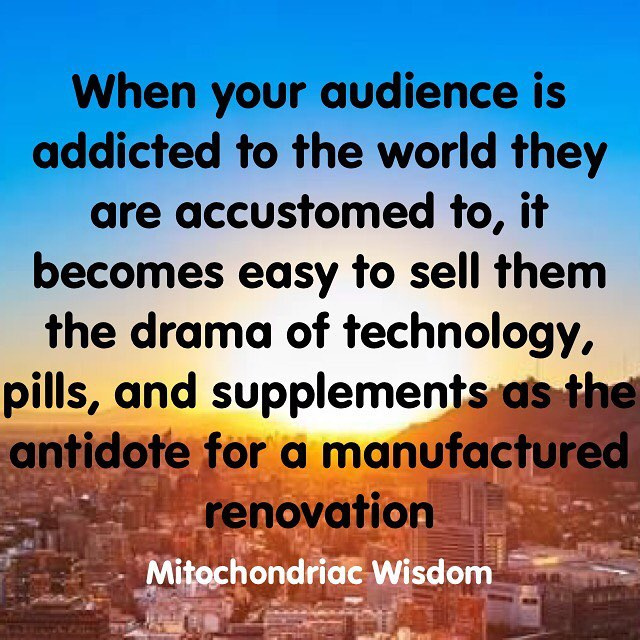
Lack of sunlight exposure decreases the production of melanin in the eyes, skin, and hair and this decreases the efficiency of the body to use sunlight to create energy.
People sleep during the day and are awake most of the night. Daytime sleep and fragmented sleep are not regenerative and do not allow cells to undergo proper autophagy, apoptosis or mitophagy.
Cells that can not perform autophagy will collect misfolded proteins that lead to autoimmunity and neurodegeneration.
Cells that can not perform apoptosis will develop cancer.

This leaves the body with poorly functioning cells and mitochondria that are disconnected from the SCN and the circadian clocks. Mitochondria develop mutations in their DNA and this reduces the REDOX possible in cells.
Poorly functioning mitochondria can be passed on to offspring by mothers. This leads to poor health and childhood diseases.
All of these unnatural environmental signals uncouple circadian rhythms and lead to epigenetic changes in how DNA is expressed.
Humans are now suffering unprecedented levels of chronic epigenetic diseases in younger and younger people. We have drastically changed our environment and lifestyle. To reverse or prevent epigenetic diseases we need to return to our natural environment.

Hat tip to Roger and Richelle Jones for posting this summary of my work.

